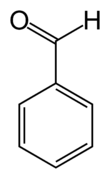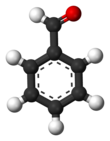
Back Bensaldehied Afrikaans بنزألدهيد Arabic Benzaldehid Azerbaijani بنزآلدهید AZB Benzaldehid Catalan Benzaldehyd Czech Benzaldehyd Danish Benzaldehyd German Βενζαλδεΰδη Greek Benzaldehido Esperanto
| |||
| Names | |||
|---|---|---|---|
| IUPAC name
Benzenecarbaldehyde
| |||
| Preferred IUPAC name
Benzaldehyde[1] | |||
| Other names
Benzenecarboxaldehyde
Phenylmethanal Benzoic aldehyde | |||
| Identifiers | |||
3D model (JSmol)
|
|||
| ChEBI | |||
| ChEMBL | |||
| ChemSpider | |||
| ECHA InfoCard | 100.002.601 | ||
| EC Number |
| ||
| KEGG | |||
PubChem CID
|
|||
| RTECS number |
| ||
| UNII | |||
| UN number | 1990 | ||
CompTox Dashboard (EPA)
|
|||
| |||
| |||
| Properties | |||
| C7H6O | |||
| Molar mass | 106.124 g·mol−1 | ||
| Appearance | colorless liquid strongly refractive | ||
| Odor | almond-like | ||
| Density | 1.044 g/mL, liquid | ||
| Melting point | −57.12[2] °C (−70.82 °F; 216.03 K) | ||
| Boiling point | 178.1 °C (352.6 °F; 451.2 K) | ||
| 6.95 g/L (25 °C)[3] | |||
| log P | 1.64[4] | ||
| -60.78·10−6 cm3/mol | |||
Refractive index (nD)
|
1.5456 | ||
| Viscosity | 1.321 cP (25 °C) | ||
| Thermochemistry | |||
Std enthalpy of
formation (ΔfH⦵298) |
−36.8 kJ/mol | ||
Std enthalpy of
combustion (ΔcH⦵298) |
−3525.1 kJ/mol | ||
| Hazards | |||
| GHS labelling: | |||

| |||
| Warning | |||
| H302 | |||
| P264, P270, P301+P312, P330, P501 | |||
| NFPA 704 (fire diamond) | |||
| Flash point | 64 °C (147 °F; 337 K) | ||
| 192 °C (378 °F; 465 K) | |||
| Explosive limits | 1.4–8.5% | ||
| Lethal dose or concentration (LD, LC): | |||
LD50 (median dose)
|
1300 mg/kg (rat, oral) | ||
| Safety data sheet (SDS) | J. T. Baker | ||
| Related compounds | |||
Related compounds
|
Benzyl alcohol Benzoic acid Benzaldehyde oxime | ||
Except where otherwise noted, data are given for materials in their standard state (at 25 °C [77 °F], 100 kPa).
| |||
Benzaldehyde (C6H5CHO) is an organic compound consisting of a benzene ring with a formyl substituent. It is among the simplest aromatic aldehydes and one of the most industrially useful.
It is a colorless liquid with a characteristic almond-like odor, and is commonly used in cherry-flavored sodas.[5] A component of bitter almond oil, benzaldehyde can be extracted from a number of other natural sources.[6] Synthetic benzaldehyde is the flavoring agent in imitation almond extract, which is used to flavor cakes and other baked goods.[7]
- ^ Nomenclature of Organic Chemistry : IUPAC Recommendations and Preferred Names 2013 (Blue Book). Cambridge: The Royal Society of Chemistry. 2014. p. 908. doi:10.1039/9781849733069-FP001. ISBN 978-0-85404-182-4.
- ^ Haynes, William M. (2014), CRC Handbook of Chemistry and Physics (95th ed.), CRC press, pp. 3–34, ISBN 9781482208689
- ^ "GESTIS Substance database". Institute for Occupational Safety and Health of the German Social Accident Insurance. Archived from the original on 3 March 2016. Retrieved 21 August 2012.
- ^ "Benzaldehyde_msds".
- ^ Loch, Christine; Reusch, Helmut; Ruge, Ingrid; Godelmann, Rolf; Pflaum, Tabea; Kuballa, Thomas; Schumacher, Sandra; Lachenmeier, Dirk W. (2016). "Benzaldehyde in cherry flavour as a precursor of benzene formation in beverages". Food Chemistry. 206: 74–77. doi:10.1016/j.foodchem.2016.03.034. PMID 27041300.
- ^ Cite error: The named reference
Ullmannwas invoked but never defined (see the help page). - ^ The Cook's Illustrated Baking Book. America's Test Kitchen. 2013. ISBN 9781936493784.
© MMXXIII Rich X Search. We shall prevail. All rights reserved. Rich X Search


